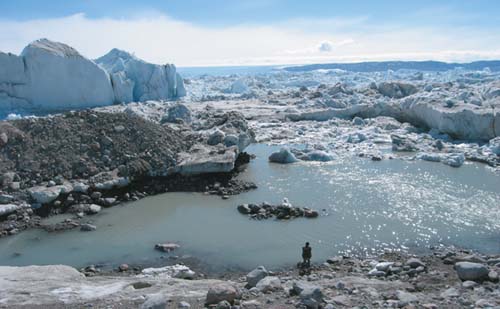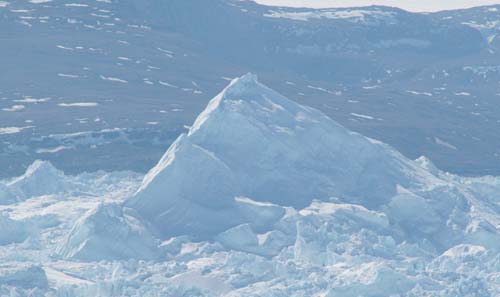 |
 |
| current issue |  |
past issues |  |
send a letter/news |  |
address update |  |
advertise |  |
about us |  |
alumni home |
Features
On Thin IcePage 2 of 2
Fahnestock spent two summers in his childhood home of Fredonia along the glacially excavated shoreline of Lake Erie in upstate New York. Every other summer, he, his mother and his older brother would travel hither and yon across North America and rough it while the elder Fahnestock, a geomorphologist and college professor, conducted his research in places like British Columbia, Alaska, Mount Rainier and the Colorado Rockies.
That lifestyle came to a sudden halt when, during Fahnestock's senior year in high school, his father was killed in a plane crash while visiting a pilot friend in Colorado. "They were just going out looking at the mountains," Fahnestock says. "He flew in a lot of little planes. I fly in little planes, and right now I'm flying in helicopters. But that's how you get to these places."
Greenland, a self-governing island dependency of Denmark, is the world's largest island and has one of the smallest national populations. Some 56,000 people, largely of Inuit heritage, occupy a small fraction of the ice-bound, 1.3-million-square-mile country. Population centers cling to a thin ribbon of ice-free coastal areas. Ilulissat, a Greenlandic word meaning "The Icebergs," has a population of around 4,000, is the country's most popular tourist destination, and has helicopter service out to Jakobshavn Isbrae for sightseeing and scientific derring-do.

|
Fahnestock, along with Martin Truffer, Roman Motyka and Jason Amundson from the University of Alaska, Fairbanks, has been flying over and onto Jakobshavn for two years in an effort to piece together the puzzle of its recent surge forward and its dramatic drop in elevation. In addition to doubling its speed in the last five years, Jakobshavn and some other big outlet glaciers have thinned from top to bottom at a rate of 30 to 50 feet per year.
Fahnestock explains, "Because the ice is flowing so much faster, it's also getting stretched, and this causes the glacier to drop and pull ice from the sides into the main channel."
Jakobshavn's change of pace could be related to the disappearance of a floating "tongue" of ice that had long choked the fjord but ripped loose in 2002 and 2003 and floated away. Jakobshavn in turn picked up speed. Did the tongue of ice act as a cork in the bottle? Or did Jakobshavn shove it out of the way as it picked up momentum? Could it be connected to warmer ocean waters and a warmer atmosphere? It's a chicken-egg situation with many dimensions, says Fahnestock.
So the ice mountain is simultaneously flowing downhill, shrinking in height, shedding icebergs off its front end and receding upwards toward the main ice sheeta--all of which makes it challenging for scientists in a helicopter to know where to land safely. What's more, due to the scale of these white behemoths, the view from above can be hard to decipher.
Peering at a satellite image of Jakobshavn taken by an instrument aboard NASA's Terra satellite, Fahnestock notes, "These are huge systems. The glacier here is nearly four miles wide. When you're up in a helicopter, it's almost impossible to know you're in the middle of it."

|
From their base camp, it takes 20 minutes via helicopter to reach the territory where they deploy the four "permanent" receivers to take readings for a full year. Twice as many temporary receivers are also deployed. The four permanent instruments will record whether the glacier moves in response to the explosive calving episodes, in which ship-sinking chunks of ice shear off its face. The scientists hope that this will provide insight into the connection between what happens at the glacier's front end and the speed at which it's flowing upstream, giving them a better idea how well the glacier is connected to its bed. The field data should, in theory, help reveal how this process varies through the seasons and shed light on what the future holds should the Arctica's current warming trend rule the day.
"If the whole glacier itself--the bottom 20 miles--is sensitive to changes at the front end," says Fahnestock, "then there's a good chance the whole lower part will go at some point, the calving face will migrate well inland, and the process could continue to accelerate."
But Earth's vacillating climate and its effect on big systems like glaciers are not an easy read, and Jakobshavn alone has many surprising chapters. During long periods of both warming and cooling, like the Medieval Warm Period (10th to 14th centuries) and the Little Ice Age (16th to 19th centuries), the world's glaciers seesawed back and forth between recession and stability.
As the Little Ice Age came to a close around 1850, Jakobshavn, as Fahnestock puts it, was a "happy glacier," settled as it was into a good stretch of stability. Then the planet warmed again. Says Fahnestock, "At that point, Jakobshavn started retreating till the 1930s. It stabilized for another 50 years, and now it's retreating like mad."
Today's measurably warmer climate, producing tepid ocean temperatures that gnaw at the bottom of big, tidewater outlet glaciers like Jakobshavn, would seem to be the obvious reason for this mad retreat. But perhaps 8,000 to 10,000 years ago, Fahnestock postulates, Jakobshavn was behaving this very same way. "Maybe what we're seeing now is the glacier continuing to respond to the end of the ice age."
Just two hundred years ago, Earth's ice ages were unknown to scientists. Evidence of glacial action--polished and scraped bedrock, huge erratic boulders, for example--was thought to be the result of diluvianism, belief that they were artifacts of the great flood of the Bible.
Humankind has come a long way in understanding the complex inner workings of our home planet. At the same time, we ourselves have become a geologic force. Perhaps Jakobshavn's current behavior is just a cyclical phenomenon, or perhaps what's happening now is but a tiny perturbation compared to what's in store for a warming planet. Whatever the case, it's up to scores of scientists like Fahnestock to tease answers out of these big, complex systems so that we can more wisely direct our newfound, globe-changing powers and chart a sustainable path to the future of life on Earth.
David Sims '81 is the science writer for the UNH Institute for the Study of Earth, Oceans, and Space.
Page: < Prev 1 2Easy to print version
blog comments powered by Disqus
